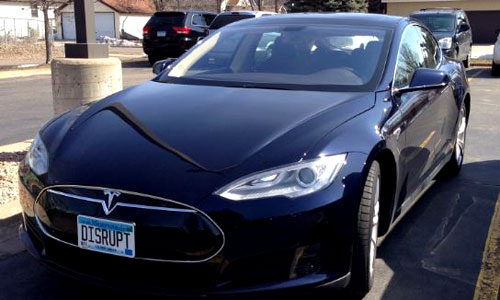Many Minnesotans are adding solar to their homes, and some folks are doing even more. Sam Villella and his family are a few of those over achievers: in addition to solar PV on their roof, they heat and cool their home with geothermal and get around in two electric vehicles. Stacey Pederson recently spoke with Sam to learn more about his experience and lessons learned when implementing energy efficiency measures and renewable energy projects.
Stacey Pederson: Can you tell me about how you became interested in energy efficiency and renewable energy?
Sam Villella: I never gave it much thought at all until I had children. They were certainly the spark that made me think about things. I am also conservative by nature and the dollars and cents of efficiency certainly made things attractive.
Stacey: What all did you do?
Sam: The first major thing I did was install a small 2.2 kW solar PV system. I didn’t really believe it would work as advertised. I was persuaded and two years later I increased the total PV system size up to 8.965kW. I retrofitted a closed loop geothermal system in between. I also switched to an on-demand hybrid natural gas water heater. We got our Chevy Volt in January 2012 and the Tesla Model S in January 2013.
Stacey: In what order did you choose to implement your ideas, and why?
Sam: I tried to start with the simple and cheap efficiency things that don’t get a lot of fanfare such as conservation, weather sealing, LED light bulbs, decreasing phantom loads, efficient appliances, ceiling fans, etc… The larger investments just came naturally as a progression.
Stacey: Where have you found the most energy and cost savings?
Sam: The on-demand natural gas hybrid water heater had the quickest payback of the major investments. When you consider a “normal” water heater and how it just keeps repeatedly heating water just in case its needed it quickly becomes evident that such a system could only be developed in a world where fuel was once ridiculously cheap. Times have changed.
Stacey: How did you decide how much solar to install?
Sam: After I really understood that the technology worked as advertised I filled my south-facing exposure. In fact, I am considering adding both east and west facing arrays before the tax credit expires.
Stacey: How do solar, geothermal, and your electric vehicles work together?
Sam: They share the key of all involving electricity. I have heard that the 21st century will be the “age of electrification” and these technologies demonstrate why that is true. Furthermore, electricity production can be accomplished in a variety of manners, some in a renewable, carbon-free fashion. The increase in this trend is evident simply due to economics.
Stacey: What informational avenues did you find helpful along the decision-making process?
Sam: I love Twitter and it is a great resource for directing you to information on the web about things you are interested in. My local electric utility, Connexus Energy, has an efficiency expert and I bounced many of my ideas off of him and that has been invaluable. Also, getting bids done and chatting with the folks who were going to be doing the work for the major projects was integral. As far as the EVs go, there is a very passionate and active community of EV owners who are an excellent resource of knowledge, ideas, and explanations (they have a growing group on Facebook, too).
Stacey: When looking back, what have you found interesting, unusual, or surprising about your experience?
Sam: I am surprised how most people really don’t think about energy and efficiency as an important component of their everyday lives. We all take it for granted and don’t give it a whole lot of thought.
Stacey: How have these projects changed your everyday habits or family lifestyle?
Sam: We still do everything pretty much the same as before, but we are much more aware of the energy needed to do these things.
Stacey: If someone is debating about installing or implementing one of the technologies you have, what advice would you give them?
Sam: Solar PV certainly is a no-brainer in the long term provided you have a good place to position the panels. The 30% federal tax credit drops down to 10% in 2017, so if considering solar PV make sure to take advantage of the credit before 12/31/2016. The federal tax credit coupled with decreases in solar PV prices have it all the more attractive. Contrary to popular misconceptions, the amount of solar resource in MN is quite good, on par with Texas and even Florida. Yes the days are short in January & February, but they are longer in June & July.
I think that geothermal is a no-brainer if propane is the primary heating fuel. With natural gas it can take longer for the payback. We had natural gas and have no regrets, but this is dependent on the size and type of home and of course on natural gas prices. We have also been happy with the improved comfort that geothermal provides. It costs us around $700 annually to heat and cool our 3,200 square-foot home.
 As far as our EVs are concerned, the saying I keep hearing is “butts in seats” and it is so true. Once you drive an EV you will not want to get back into an internal-combustion engine (ICE) vehicle. The acceleration and performance are incredible. Add to that amazing efficiency gains, decreased operating costs, decreased maintenance hassles and costs, and improved safety due to battery weight and it just keeps getting better. Additionally, if you charge your car on an off-peak program at night, the energy is typically half price. It costs us about $55 per month to push our two EVs 2,500 miles.
As far as our EVs are concerned, the saying I keep hearing is “butts in seats” and it is so true. Once you drive an EV you will not want to get back into an internal-combustion engine (ICE) vehicle. The acceleration and performance are incredible. Add to that amazing efficiency gains, decreased operating costs, decreased maintenance hassles and costs, and improved safety due to battery weight and it just keeps getting better. Additionally, if you charge your car on an off-peak program at night, the energy is typically half price. It costs us about $55 per month to push our two EVs 2,500 miles.
Stacey: Is there anything else that you feel I’ve missed or you’d like to share?
Sam: Technology innovations and economics have changed things dramatically and a lot of people haven’t been paying attention! Kind of a quiet revolution. I put together a bit of a presentation about all of this if you’d like to check it out.
Check out Sam’s presentation here:
More Resources:
 |
The Get Answers series on the Energy Stories Blog offers useful tips from CERTs and our partners to help you get to the bottom of your energy efficiency and renewable energy questions. Click here to see more stories in the series >> |


